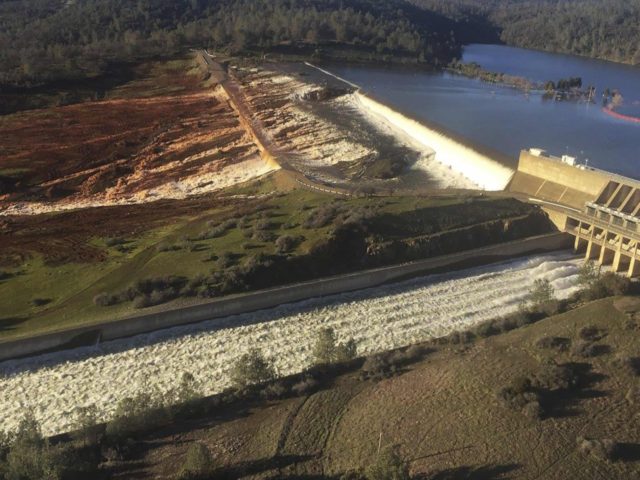Congressman Doug LaMalfa (R-CA), who represents California’s first congressional district, told Breitbart News Sunday that authorities suggested the structural integrity of the Oroville Dam’s spillway was not sound and that its potential failure could be the result of a collapse at its center.
“They said the spillway might have had a collapse in the middle of it,” LaMalfa told Breitbart News. “They stopped it for a day and have been using it at half speed all this time with a broken-out spillway, and in that situation, the lake kept filling,” he explained.
Emergency evacuations were placed from Oroville to Gridley. Butte County and low-lying areas of Yuba County were also evacuated.
LaMalfa, who can see Lake Oroville from his home, said he and his family were not evacuating because they are in a spot that is not in the flow line of the dam, which made it safe for them to stay put. He noted that the highways were extremely jammed.
Oroville’s population is approximately 60,000 people.
“They are evacuating everything that’s below the dam for a good 20 miles. They are not fooling around here. It’s an emergency,” LaMalfa said.
LaMalfa conveyed that water was pouring into the lake at 42,000 cubic feet per second. “They’re letting it out of the lake at about 100,000 cubic feet at this present moment,” adding,” they might be upping that to 125,000.”
“The main dam’s integrity is solid, but the emergency spillway is a concrete structure that no water has ever gone over as an emergency measure,” LaMalfa said. He added this was the first time since the dam opened that water was dumped over the emergency spillway.
The Oroville Dam is America’s tallest dam. It opened in 1968.
Although there is no map showing what would happen if the Oroville dam’s emergency spillway collapses, the Sacramento Bee used GIS maps controlled by CalFire to calculate that in the unlikely event that the dam fails completely, the flood waters could reportedly reach over 100 feet in Oroville.
Water would reportedly reach the town of Oroville within one hour and the small neighboring town of Briggs in two hours. It would take three hours to arrive at the Gridley and five to reach Live Oak.
“The intake is lowering now, but it needs to go down 20 feet to have this thing that’s going on right now not be a problem,” LaMalfa said. “The emergency structure holds back 20 feet of water across the entire lake.”
LaMalfa said he spoke with engineers from the water resource agency who told him that inspections of the dam had passed every time. “Now, they are theorizing that the original design was built up on some area of rock called weathered rock” and noted that “if they were building the dam today, they would have gone deeper to more solid bedrock.”
Weathered rock is not as solid as the bedrock that rests beneath its surface. LaMalfa explained that as water cascades down the spillway, it can cause an oscillation to start and a vibration which, over the years, can cause the weathered rock to chip, crack and deteriorate. He explained this, in turn, could cause the area of poured concrete over the spillway to crack and cave in after several years. “That’s what the engineers are suggesting,” LaMalfa said.
He noted that the Oroville Lake was 40 percent on December 8, but that it was overwhelmed with the influx of precipitation the Golden State has received. “We’ve had an incredible amount of rain and snow in only two months. We haven’t seen it like this in a long time. They’ve been letting water out,” he added.
He sent a message of caution to residents in his district and urged them to get to safety and do “whatever they need to do” to ensure they are out of harm’s way.
Reports of thefts and people looting homes that have been evacuated surfaced over social media:
https://twitter.com/JmonaReviews/status/830996729067483136
https://twitter.com/goldsteinstreet/status/830995397522763776
“We will be calling upon the president to have the Federal Government have its declaration of emergency” for California, LaMalfa said. “The federal government has a 20 percent role in the dam. There is a federal nexus here.”
“Until you see that lake drop to 880 feet or lower of this story is not going away.” In the meantime, LaMalfa said, “the State of California will be doing their job.”
Follow Adelle Nazarian on Twitter and Periscope @AdelleNaz

COMMENTS
Please let us know if you're having issues with commenting.